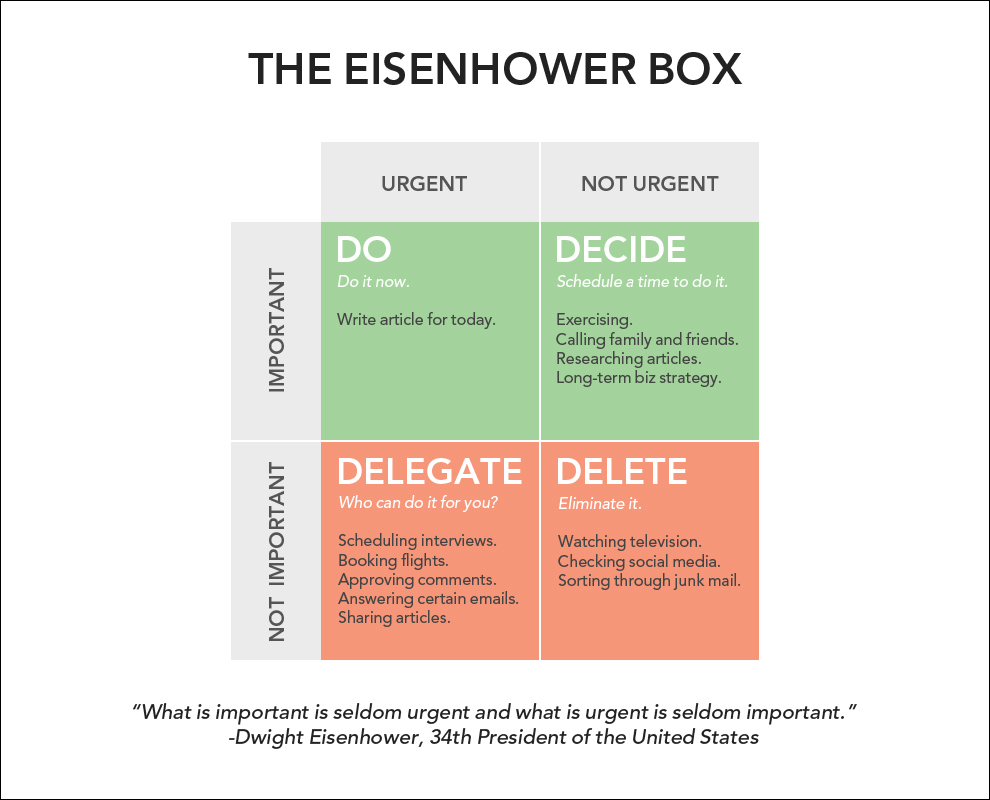If you are really busy then STOP – take five minutes to read this…
If you ask someone ‘how they are?’ there is a good chance that you will be met with a response that in some way alludes to how ‘busy’ they are.
The world today is filled with choice and opportunities. Every single day we are presented with hundreds of opportunities, forks in the road which present us with the need to make a decision – should we do something or nothing?
Added to this overwhelming number of choices, there is an expectation that we must keep ‘delivering’. We need to keep smashing through tasks and achieving goals so that we can demonstrate that we are making a difference and having an impact.
This creates a never-ending cycle of taking on more work and committing to delivering more. The simple assumption that if you work harder, you will deliver more used to be a philosophy that I subscribed to.
I believe that ‘necessity is the mother of invention’.
Therefore, in order to become more productive and to improve, I believed that I needed to take on more and commit to delivering more. This would ‘make it necessary’ for me to adjust and in turn, I’d be able to deliver more.
The easiest way I can explain this is by describing how I used to exercise. I had been led to believe that in order to improve physically, I needed to do more. There are a lot of people that subscribe to this view. I used to train five days per week, sometimes more, religiously. I wanted to ‘lead by example’ and be fitter than those that I led so I worked harder… not necessarily smarter.
My assumption that health was simply a combination of 50% diet and 50% exercise meant that if I pushed hard on the exercise, I could be more relaxed about what I eat. This was a completely flawed assumption. I am now starting to understand that diet, sleep, exercise, meditation all play a part in your overall ‘wellbeing’ and have an impact on your performance – both physical and mental.
If we take this philosophy back to the work place, I was the person who was consistently looking to work harder believing that it was the key to success when in actual fact it is all about working smarter.
At some point, everyone who believes in the ‘working harder philosophy’ will plateau or crash. There aren’t enough hours in the day to do everything that you want to so you are forced to prioritise. If you keep trying to do everything and beat yourself up when you fail to deliver on this expectation – you’re not going to be a very happy and productive person.
How to work smarter – the art of prioritisation
I was first introduced to the Eisenhower matrix in Stephen Covey’s, ‘Seven Habits of Highly Successful People’.
Dwight Eisenhower lived one of the most productive lives imaginable. He was a five-star general in the US Army during which he served as Supreme Allied Commander of the Allied Forces in Europe. He served two terms in office as the US President and he developed the interstate highway system and NASA amongst other great achievements. He also took time to enjoy a bit of Golf and painting!
In order to sustain this incredible productivity, he produced the Eisenhower matrix as a simple decision-making tool.
All work basically falls into four categories, which are a combination of urgent and important.
- Urgent and important (tasks you will do immediately)
- Important, but not urgent (tasks you will schedule to do later)
- Urgent, but not important (tasks you will delegate to someone else)
- Neither urgent nor important (tasks that you will eliminate)
These are illustrated in the box below with some examples.

Productive people live in the top right box most of the time. In fact, their productivity can be measured by how much of their time in a typical week is spent delivering tasks that are in the top right box. The least productive people live in any combination of the other three boxes.
Many of us work in the top left box. This is the world of the fire fighter. We spend our day responding to crises. We are needed to help ‘sort things out and get things done’. For many, this is what they think constitutes leadership. Chances are, they’ve picked up on this example from other people who live in this space.
A leader who is constantly fire fighting is ineffective.
They are still stuck in the ‘delivery’ mentality when they should be focussed on making sure that the fires don’t happen.
Some people even like being in the top left. Being a fire fighter is fun, it is exciting and you’re always in demand. But on the flip-side it is stressful, chaotic and unstructured. It is also unsustainable.
Strong leaders consistently operate in the top right box. Occasionally they might have to stray into the top left. If they do, they will seek to understand what happened so that they can learn from it and make sure it doesn’t happen again. They never do anything in the bottom boxes.
So how do I get into the top right box?
In order to get into the top right box you need to have the following…
- A vision for the future (vision)
- A plan to get there (strategy)
- Metrics which measure how well you are progressing towards that vision (KPIs)
- Clear standards for the best way to do given tasks
Most importantly – Leaders must also spend time improving the performance of their people. This is probably the most significant ‘top left’ activity.
Improve the performance of your people and you will improve the delivery of your service to the customer. Improve the impact you have on customer and you will create a virtuous circle in which people come back to you. In turn, this creates demand for your services which fuels growth.
Productivity is not about ‘getting things done’. It is about getting the right things done. The right things include working on the list above and helping your people to get better at what they do.
Living in the top right box is a choice.
You can either choose to live there or in any combination of the other three.
What are you going to do today? What is on your task list? Having a task list does not mean that you are automatically in the top right box.
Why don’t you take five minutes to draw up this matrix and see which buckets your tasks fall into?
We all like to think that we’re productive but it is easy to slip into doing the easier and more enjoyable tasks as opposed to the necessary ones.
Use the Eisenhower matrix to assess whether you should do the tasks in the first place and you will create time to focus on the things that really matter.
This is how you use time effectively, it is how you develop and it is how you make a real impact on your performance.
If you’ve enjoyed this article and found it useful – please like and share, you’ll be doing me a huge favour!
If you’d like to have a conversation about the Eisenhower matrix or anything connected to improving your leadership capability or the leadership capability of your team, please feel free to get in touch – roderic.yapp@leadershipforces.com
Share this article:




